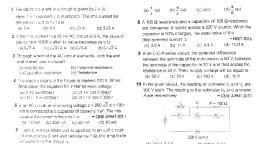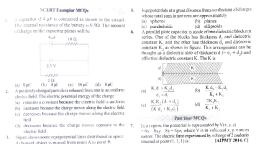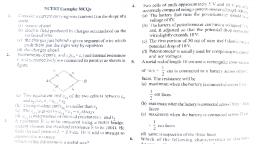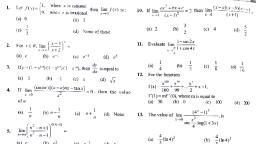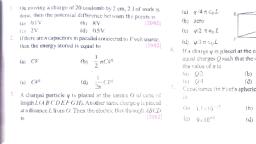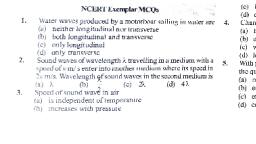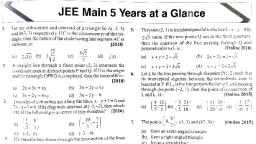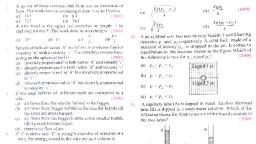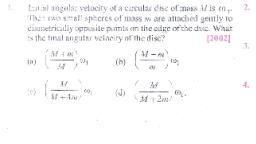Question 1 :
A stone of mass 0.5 kg tied with a string of length 1 metre is moving in a circular path with a speed of 4 m s<sup>-1</sup>. The tension acting on the string in newton is
Question 2 :
The ceiling of a long hall is 25{tex} \mathrm { m } {/tex} high. What is the maximum horizontal distance that a ball thrown with a speed of 40{tex} \mathrm { ms } ^ { - 1 } {/tex} can go without hitting the ceiling of the hall?
Question 3 :
A uniform chain of length $2$ m is kept on a table such that a length of $60$ cm hangs freely from the edge of the table. The total mass of the chain is $4$ kg. What is the work done in pulling the entire chain on the table?
Question 4 :
<font>A body of mass 2 kg is being dragged with a uniform velocity of 2 ms</font><sup><font>-1</font></sup><font> on a horizontal plane. The coefficient of friction between the body and the surface is 0.2. Work done in 5s is</font></p>
Question 5 :
To avoid slipping while walking on ice, one should take smaller steps because:<br>
Question 6 :
Two trolleys 1 and 2 are moving with acceleration a<sub>1</sub> and a<sub>2</sub> respectively in the same direction. A block of mass 'm' on trolleys 1 is in equilibrium from the frame of observer stationary w.r.t. trolleys 2. The magnitude of friction on block due to trolley is -<br><img style='object-fit:contain' src='https://storage.googleapis.com/teachmint/question_assets/JEE%20Main/5e75ed85491ec95800698533' height='66' width='206' >
Question 7 :
The upper half of an inclined plane of inclination $\theta$ is perfectly smooth while the lower half is rough $A$ body starting from the rest at top come back to rest at the bottom, then the coefficient of friction for the lower half is given by _______.
Question 8 :
The position of the centre of mass of a cube of uniform mass density will be at
Question 9 :
<font>A horizontal platform is rotating with uniform angular velocity around the vertical axis passing through its centre. At some instant a viscous fluid of mass m is dropped at the centre and is allowed to spread out and finally fall. The angular velocity during this period.</font></p>
Question 10 :
<font>The reduce mass of two particles having masses </font><font><i>m</i></font><font> and </font><font><i>2 mis</i></font></p> <p> <font color="#000000">
Question 11 :
The escape velocity on earth is {tex} 11.2 \mathrm { km } / \mathrm { s } {/tex}. On another planet having twice radius and {tex} {8} {/tex} times mass of the earth, the escape velocity will {tex} b e {/tex}<br>
Question 12 :
The value of g on the surface of earth is 9.8 m/s<sup>2</sup> & the radius of earth is 6400 km. The avg. density of earth in kg/m<sup>3</sup> will be
Question 13 :
The weight of body on earth is 60 N. Its weight on moon will be :
Question 14 :
For a solid sphere of radius <em>R</em> and mass <em>M</em>, the magnitude of gravitational field <em>g</em> and potential <em>V</em> due to the sphere at a distance ‘<em>r</em>’ from its centre are such that
Question 15 :
Assertion: Assertion : Gravitational force is always attractive in nature, while electromagnetic force can be attractive or repulsive.
Reason: Reason : Electromagnetic force dominates terrestrial phenomena.
Question 16 :
<font>The escape velocity of a projectile from the earth is approximately -</font></p>
Question 17 :
<font>In motion of an object under the gravitational influence of another object. Which of the following quantities is not conserved ?</font></p>
Question 19 :
The stress-s-strain curves for brass, steel and rubber are shown in the figure. The lines {tex} A , B {/tex} and {tex} C {/tex} are for<img style='object-fit:contain' src="https://storage.googleapis.com/teachmint/question_assets/JEE%20Main/5dc3d0d4e18860128132dde3">
Question 20 :
If the work done in blowing a soap bubble of volume <em>V</em> is <em>W</em>, then the work done in blowing a soap bubble of volume 2<em>V</em> will be
Question 21 :
The volume of a liquid flowing per sec out of an orifice at the bottom of a tank does not depend upon
Question 22 :
{tex} \mathrm { Assertion } :\quad {/tex} Glassy solids have sharp meling point.<br>{tex} \mathrm { Reason} :\quad {/tex} The bonds between the atoms of glassy solids get broken at the same temperature.
Question 23 :
Work done in splitting a drop of water of 1 mm radius into 64 droplets is (Surface tension of water is 72 <font face="Symbol">×</font> 10<sup>–3</sup> J/m<sup>2</sup>)
Question 25 :
The value of force constant between the applied elastic force {tex} F {/tex} and displacement will be<img style='object-fit:contain' src="https://storage.googleapis.com/teachmint/question_assets/JEE%20Main/5dc3d0c1e18860128132ddce">

